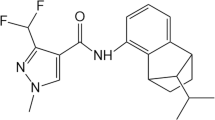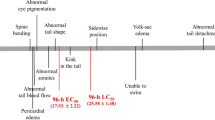Abstract
Cyproconazole is a triazole fungicide used to protect a diverse range of fruits, vegetables, and grain crops. As such, it has the potential to enter aquatic environments and affect non-target organisms. The objective of this study was to assess the acute toxicity of the triazole fungicide cyproconazole to zebrafish embryos by assessing mortality, developmental defects, morphological abnormality, oxidative respiration, and locomotor activity following a 96-h exposure. Zebrafish embryos at 6-h post-fertilization (hpf) were exposed to either a solvent control (0.1% DMSO, v/v), or one dose of 10, 25, 50, 100, 250, and 500 μM cyproconazole for 96 h. Data indicated that cyproconazole exhibited low toxicity to zebrafish embryos, with a 96-h LC50 value of 90.6 μM (~ 26.4 mg/L). Zebrafish embryos/larvae displayed a significant decrease in spontaneous movement, hatching rate, and heartbeats/20 s with 50, 100, and 250 μM cyproconazole exposure. Malformations (i.e., pericardial edema, yolk sac edema, tail deformation, and spine deformation) were also detected in zebrafish exposed to ≥ 50 μM cyproconazole, with significant increases in cumulative deformity rate at 48, 72, and 96 hpf. In addition, a 20–30% decrease in basal and oligomycin-induced ATP respiration was observed after 24-h exposure to 500 μM cyproconazole in embryos. To determine if cyproconazole affected locomotor activity, a dark photokinesis assay was conducted in larvae following 7-day exposure to 1, 10, and 25 μM cyproconazole in two independent trials. Activity in the dark period was decreased for zebrafish exposed to 25 μM cyproconazole in the first trial, and hypoactivity was also observed in zebrafish exposed to 1 μM cyproconazole in a second trial, suggesting that cyproconazole can affect locomotor activity. These data improve understanding of the toxicity of cyproconazole in developing zebrafish and contribute to environmental risk assessments for the triazole fungicides on aquatic organisms. We report that, based on the overall endpoints assessed, cyproconazole exhibits low risk for developing fish embryos, as many effects were observed above environmentally-relevant levels.





Similar content being viewed by others
Abbreviations
- dpf:
-
Days post-fertilization
- hpf:
-
Hours post-fertilization
- OCR:
-
Oxygen consumption rate
- PE:
-
Pericardial edema
- SD:
-
Spinal deformation
- TD:
-
Tail deformation
- YSE:
-
Yolk sac edema
References
Andreu-Sanchez O, Paraiba LC, Jonsson CM, Carrasco JM (2012) Acute toxicity and bioconcentration of fungicide tebuconazole in zebrafish (Danio rerio). Environ Toxicol 27(2):109–116
Battaglin WA, Sandstrom MW, Kuivila KM, Kolpin DW, Meyer MT (2011) Occurrence of azoxystrobin, propiconazole, and selected other fungicides in US streams, 2005–2006. Water Air Soil Pollut 218(1):307–322
Bestman JE, Stackley KD, Rahn JJ, Williamson TJ, Chan SS (2015) The cellular and molecular progression of mitochondrial dysfunction induced by 2,4-dinitrophenol in developing zebrafish embryos. Differentiation 89(3-4):51–69
Blaser RE, Penalosa YM (2011) Stimuli affecting zebrafish (Danio rerio) behavior in the light/dark preference test. Physiol Behav 104(5):831–837
Blaser RE, Chadwick L, McGinnis GC (2010) Behavioral measures of anxiety in zebrafish (Danio rerio). Behav Brain Res 208(1):56–62
Bromilow RH, Evans AA, Nicholls PH (1999) Factors affecting degradation rates of five triazole fungicides in two soil types: 1. Laboratory incubations. Pestic Sci 55(12):1129–1134
Cao F, Souders CL, Li P, Adamovsky O, Pang S, Qiu L, Martyniuk CJ (2019) Developmental toxicity of the fungicide ziram in zebrafish (Danio rerio). Chemosphere 214:303–313
Coors A, Frische T (2011) Predicting the aquatic toxicity of commercial pesticide mixtures. Environ Sci Eur 23(1):22
De Gaspar I, Blanquez MJ, Fraile B, Paniagua R, Arenas MI (1999) The hatching gland cells of trout embryos: characterisation of N- and O-linked oligosaccharides. J Anat 194(Pt 1):109–118
De la Paz JF, Beiza N, Paredes-Zuniga S, Hoare MS, Allende ML (2017) Triazole fungicides inhibit zebrafish hatching by blocking the secretory function of hatching gland cells. Int J Mol Sci 18(4)
DiMauro S, Schon EA (2008) Mitochondrial disorders in the nervous system. Annu Rev Neurosci 31:91–123
EFSA (2010) Conclusion on the peer review of the pesticide risk assessment of the active substance cyproconazole. EFSA J 8(11):1897
Guo J, Wenhua S, Feng D, Jinyang Z, Zhen L, Xiaoying C, Jinhua Z, Jie L (2010) Acute toxicity study on zebrafish ( Danio rerio) exposure to triazole fungicides. J Southeast Univ 29(4):402–406 (in Chinese)
Hermsen SA, Pronk TE, van den Brandhof EJ, van der Ven LT, Piersma AH (2011a) Chemical class-specific gene expression changes in the zebrafish embryo after exposure to glycol ether alkoxy acids and 1,2,4-triazole antifungals. Reprod Toxicol 32(2):245–252
Hermsen SA, van den Brandhof EJ, van der Ven LT, Piersma AH (2011b) Relative embryotoxicity of two classes of chemicals in a modified zebrafish embryotoxicity test and comparison with their in vivo potencies. Toxicol in Vitro 25(3):745–753
Hermsen SA, Pronk TE, van den Brandhof EJ, van der Ven LT, Piersma AH (2012) Triazole-induced gene expression changes in the zebrafish embryo. Reprod Toxicol 34(2):216–224
Hill AJ, Teraoka H, Heideman W, Peterson RE (2005) Zebrafish as a model vertebrate for investigating chemical toxicity. Toxicol Sci 86(1):6–19
Icoglu Aksakal F, Ciltas A (2018) Developmental toxicity of penconazole in Zebrfish (Danio rerio) embryos. Chemosphere 200:8–15
Jin M, Zhang X, Wang L, Huang C, Zhang Y, Zhao M (2009) Developmental toxicity of bifenthrin in embryo-larval stages of zebrafish. Aquat Toxicol 95(4):347–354
de Jong E, Barenys M, Hermsen SA, Verhoef A, Ossendorp BC, Bessems JG, Piersma AH (2011) Comparison of the mouse Embryonic Stem cell Test, the rat Whole Embryo Culture and the Zebrafish Embryotoxicity Test as alternative methods for developmental toxicity testing of six 1,2,4-triazoles. Toxicol Appl Pharmacol 253(2):103–111
Kahle M, Buerge IJ, Hauser A, Müller MD, Poiger T (2008) Azole fungicides: occurrence and fate in wastewater and surface waters. Environ Sci Technol 42(19):7193–7200
Kane AS, Salierno JD, Brewer SK (2005) Fish models in behavioral toxicology: automated techniques, updates and perspectives. Methods in Aquatic Toxicology 2:559–590
Kimmel CB, Ballard WW, Kimmel SR, Ullmann B, Schilling TF (1995) Stages of embryonic development of the zebrafish. Dev Dyn 203(3):253–310
Liu S, Chang J, Zhu G. 2010. Developmental toxicity of triadimefon in embryo-larval stages of zebrafish. International Conference on Digital Manufacturing & Automation:552-555.
Liu HC, Chu TY, Chen LL, Gui WJ, Zhu GN (2017) The cardiovascular toxicity of triadimefon in early life stage of zebrafish and potential implications to human health. Environ Pollut 231(Pt 1):1093–1103
Machera K (1995) Developmental toxicity of cyproconazole, an inhibitor of fungal. Bull Environ Contam Toxicol 54(3):363–369
Magno LD, Fontes A, Goncalves BM, Gouveia A Jr (2015) Pharmacological study of the light/dark preference test in zebrafish (Danio rerio): waterborne administration. Pharmacol Biochem Behav 135:169–176
Manjunatha B, Wei-bing P, Ke-chun L, Marigoudar SR, Xi-qiang C, Xi-min W, Xue W (2014) The effects of henna (hair dye) on the embryonic development of zebrafish (Danio rerio). Environ Sci Pollut Res Int 21(17):10361–10367
Maximino C, de Brito TM, da Silva Batista AW, Herculano AM, Morato S, Gouveia A Jr (2010) Measuring anxiety in zebrafish: a critical review. Behav Brain Res 214(2):157–171
McGrath P, Li CQ (2008) Zebrafish: a predictive model for assessing drug-induced toxicity. Drug Discov Today 13(9-10):394–401
Mu X, Pang S, Sun X, Gao J, Chen J, Chen X, Li X, Wang C (2013) Evaluation of acute and developmental effects of difenoconazole via multiple stage zebrafish assays. Environ Pollut 175:147–157
Mu X, Chai T, Wang K, Zhang J, Zhu L, Li X, Wang C (2015a) Occurrence and origin of sensitivity toward difenoconazole in zebrafish (Danio reio) during different life stages. Aquat Toxicol 160:57–68
Mu X, Wang K, Chai T, Zhu L, Yang Y, Zhang J, Pang S, Wang C, Li X (2015b) Sex specific response in cholesterol level in zebrafish (Danio rerio) after long-term exposure of difenoconazole. Environ Pollut 197:278–286
Nagel R (2002) DarT: the embryo test with the Zebrafish Danio rerio--a general model in ecotoxicology and toxicology. ALTEX 19(Suppl 1):38–48
OECD. 2013. OECD Guidelines for the Testing of Chemicals. In: Section 2: Effects on Biotic Systems Test No. 236: Fish Embryo Acute Toxicity (FET) Test. OECD. Paris.
Palmer T, Ek F, Enqvist O, Olsson R, Astrom K, Petersson P (2017) Action sequencing in the spontaneous swimming behavior of zebrafish larvae - implications for drug development. Sci Rep 7(1):3191
Peffer RC, Moggs JG, Pastoor T, Currie RA, Wright J, Milburn G, Waechter F, Rusyn I (2007) Mouse liver effects of cyproconazole, a triazole fungicide: role of the constitutive androstane receptor. Toxicol Sci 99(1):315–325
Pinho BR, Santos MM, Fonseca-Silva A, Valentao P, Andrade PB, Oliveira JM (2013) How mitochondrial dysfunction affects zebrafish development and cardiovascular function: an in vivo model for testing mitochondria-targeted drugs. Br J Pharmacol 169(5):1072–1090
Scholz S, Fischer S, Gundel U, Kuster E, Luckenbach T, Voelker D (2008) The zebrafish embryo model in environmental risk assessment--applications beyond acute toxicity testing. Environ Sci Pollut Res Int 15(5):394–404
Schoots AFM, Stikkelbroeck JJM, Bekhuis JF, Denucé JM (1982) Hatching in teleostean fishes: fine structural changes in the egg envelope during enzymatic breakdown in vivo and in vitro. J Ultrastruct Res 80(2):185–196
Selderslaghs IW, Hooyberghs J, De Coen W, Witters HE (2010) Locomotor activity in zebrafish embryos: a new method to assess developmental neurotoxicity. Neurotoxicol Teratol 32(4):460–471
Souders CL 2nd, Liang X, Wang X, Ector N, Zhao YH, Martyniuk CJ (2018) High-throughput assessment of oxidative respiration in fish embryos: advancing adverse outcome pathways for mitochondrial dysfunction. Aquat Toxicol 199:162–173
Sreedevi B, Suvarchala G, Philip GH (2014) Morphological and physiological abnormalities during development in zebrafish due to chlorpyrifos. Indian J Sci Res 5(2):1–8
Taxvig C, Hass U, Axelstad M, Dalgaard M, Boberg J, Andeasen HR, Vinggaard AM (2007) Endocrine-disrupting activities in vivo of the fungicides tebuconazole and epoxiconazole. Toxicol Sci 100(2):464–473
Teng M, Zhu W, Wang D, Qi S, Wang Y, Yan J, Dong K, Zheng M, Wang C (2018) Metabolomics and transcriptomics reveal the toxicity of difenoconazole to the early life stages of zebrafish (Danio rerio). Aquat Toxicol 194:112–120
Theunissen PT, Robinson JF, Pennings JL, de Jong E, Claessen SM, Kleinjans JC, Piersma AH (2012) Transcriptomic concentration-response evaluation of valproic acid, cyproconazole, and hexaconazole in the neural embryonic stem cell test (ESTn). Toxicol Sci 125(2):430–438
Tierney KB (2011) Behavioural assessments of neurotoxic effects and neurodegeneration in zebrafish. Biochim Biophys Acta 1812(3):381–389
Ulhaq M, Orn S, Carlsson G, Morrison DA, Norrgren L (2013) Locomotor behavior in zebrafish (Danio rerio) larvae exposed to perfluoroalkyl acids. Aquat Toxicol 144-145:332–340
Wang C, Wu Q, Wu C, Wang Z (2011) Application of dispersion-solidification liquid-liquid microextraction for the determination of triazole fungicides in environmental water samples by high-performance liquid chromatography. J Hazard Mater 185(1):71–76
Wang XH, Souders CL 2nd, Zhao YH, Martyniuk CJ (2018a) Paraquat affects mitochondrial bioenergetics, dopamine system expression, and locomotor activity in zebrafish (Danio rerio). Chemosphere 191:106–117
Wang XH, Zheng SS, Huang T, Su LM, Zhao YH, Souders CL, Martyniuk CJ (2018b) Fluazinam impairs oxidative phosphorylation and induces hyper/hypo-activity in a dose specific manner in zebrafish larvae. Chemosphere 210:633–644
Zhang JL, Laurence Souders C 2nd, Denslow ND, Martyniuk CJ (2017) Quercetin, a natural product supplement, impairs mitochondrial bioenergetics and locomotor behavior in larval zebrafish (Danio rerio). Toxicol Appl Pharmacol 327:30–38
ZION. 2017. Fungicides market (chloronitriles, dithiocarbamates, triazoles, strobilurins, benzimidazoles, mancozeb and others) for fruit & vegetables, oilseeds & pulses, cereals & grains, and other crops: global industry perspective, comprehensive analysis, and forecast, 2016 – 2022. Zion Market Research https://www.zionmarketresearch.com/news/fungicides-market. (19th September ):1-110.
Zoupa M, Machera K (2017) Zebrafish as an alternative vertebrate model for investigating developmental toxicity-the triadimefon example. Int J Mol Sci 18(4)
Acknowledgments
We thank Edward Flynn and Animal Care Services at U Florida for zebrafish husbandry and technical support.
Funding
This research is funded by the University of Florida, the College of Veterinary Medicine (CJM), and by the China Scholarship Council (CSC) for Fangjie Cao (No. 201706350062) to visit the University of Florida.
Author information
Authors and Affiliations
Corresponding author
Ethics declarations
Conflict of interest
The authors declare that they have no conflict of interest.
Additional information
Responsible editor: Markus Hecker
Electronic supplementary material
ESM 1
(DOCX 303 kb)
Rights and permissions
About this article
Cite this article
Cao, F., Souders, C.L., Li, P. et al. Developmental toxicity of the triazole fungicide cyproconazole in embryo-larval stages of zebrafish (Danio rerio). Environ Sci Pollut Res 26, 4913–4923 (2019). https://doi.org/10.1007/s11356-018-3957-z
Received:
Accepted:
Published:
Issue Date:
DOI: https://doi.org/10.1007/s11356-018-3957-z




